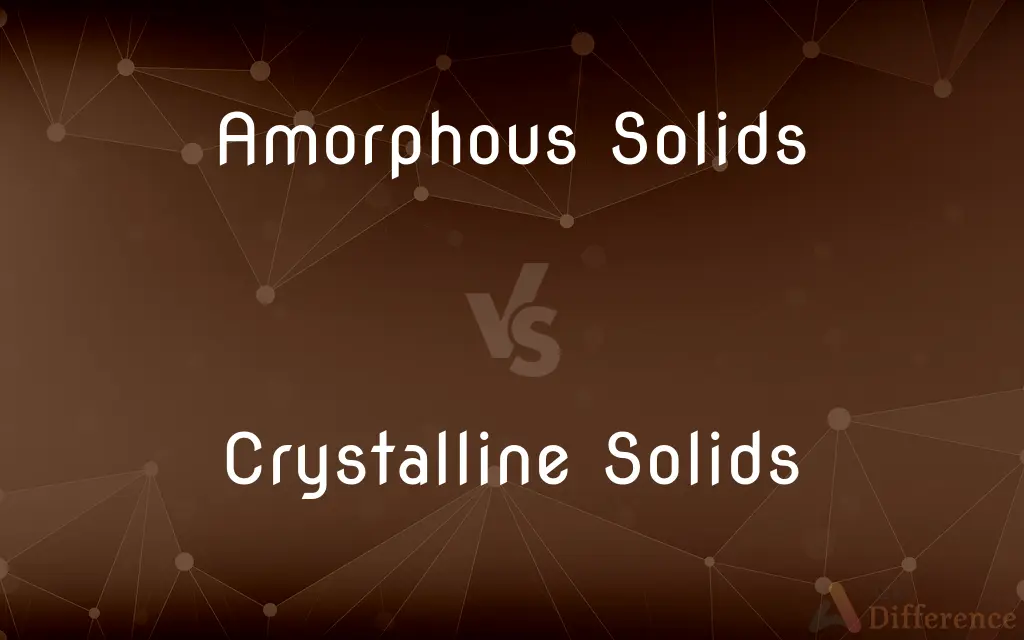Amorphous Solids vs. Crystalline Solids — What's the Difference?
By Tayyaba Rehman — Published on January 7, 2024
Amorphous solids have a non-ordered structure, whereas crystalline solids feature a regular, repeating pattern.

Difference Between Amorphous Solids and Crystalline Solids
Table of Contents
ADVERTISEMENT
Key Differences
Amorphous solids are materials with a random, disordered arrangement of atoms or molecules, lacking a long-range, periodic atomic structure. In contrast, crystalline solids have a highly ordered structure, with atoms, ions, or molecules arranged in a consistent, repeating pattern that extends throughout the material. While amorphous solids exhibit isotropic behavior, meaning their physical properties are the same in all directions, crystalline solids are often anisotropic, exhibiting different properties in different directions due to their ordered structure.
The internal arrangement of amorphous solids does not reflect a regular geometric lattice, which results in the absence of sharp melting points. Crystalline solids, however, have a sharp melting point where the orderly lattice breaks down at a specific temperature. The lack of a defined shape in amorphous solids such as glass or plastics makes them more suitable for certain applications, while the precise angles and planes in crystalline solids like diamonds or quartz are crucial for others.
In terms of mechanical strength, amorphous solids usually have a gradual softening temperature and can be more ductile, whereas crystalline solids have distinct, more predictable mechanical properties and can be very hard and brittle. This makes crystalline materials preferable for structural applications where consistent behavior under stress is critical, whereas amorphous materials are often chosen for their gradual deformation characteristics.
Optical properties also distinguish amorphous from crystalline solids; the uniformity in crystalline structures can lead to unique optical phenomena such as birefringence, while amorphous solids typically do not exhibit such properties due to their lack of long-range order. As a result, the transparency of amorphous materials like common glass is ideal for applications requiring light transmission, whereas the specific optical properties of crystalline materials are harnessed in electronics and laser technology.
Thermal conductivity in amorphous solids tends to be lower due to the disorganized structure, which scatters phonons, whereas crystalline solids often have higher thermal conductivity as their well-ordered lattice allows for efficient heat transfer. This fundamental difference is exploited in various applications, such as thermal insulation using amorphous substances or heat sinks using crystalline substances.
ADVERTISEMENT
Comparison Chart
Structure
Non-ordered
Regularly ordered
Melting Point
Gradual
Sharp
Examples
Glass, rubber
Salt, diamonds
Properties
Isotropic
Anisotropic
Atomic Arrangement
Random
Lattice
Compare with Definitions
Amorphous Solids
Solids with disordered atomic structure.
Glass is a common amorphous solid.
Crystalline Solids
Materials with long-range atomic order.
Table salt is a classic example of a crystalline solid.
Amorphous Solids
Solids with gradual melting points.
Wax, an amorphous solid, melts gradually.
Crystalline Solids
Materials with atoms in a lattice.
Crystals in snowflakes are crystalline solids.
Amorphous Solids
Substances with isotropic properties.
Amorphous solids like glass transmit light uniformly.
Crystalline Solids
Substances with anisotropic properties.
Crystalline solids like quartz exhibit unique optical properties.
Amorphous Solids
Solids lacking a crystalline structure.
Rubber, as an amorphous solid, has flexible properties.
Crystalline Solids
Solids with sharp melting points.
Sugar, a crystalline solid, has a precise melting point.
Amorphous Solids
Materials without long-range order.
Plastic is an amorphous solid used widely.
Crystalline Solids
Solids with a regular, repeating structure.
Diamonds are crystalline solids with a hard structure.
Common Curiosities
Define Amorphous Solids.
They're solids with a non-ordered atomic arrangement.
Do Amorphous Solids have a sharp melting point?
No, they have gradual melting points.
Give an example of a Crystalline Solid.
Salt is a classic example.
Are Crystalline Solids anisotropic?
Yes, they often display anisotropic characteristics.
How are atoms arranged in Amorphous Solids?
They are arranged randomly, without a set pattern.
Is diamond an Amorphous Solid?
No, diamond is a Crystalline Solid.
What are Crystalline Solids?
Solids with a regular, repeating atomic structure.
Do Crystalline Solids have distinct melting points?
Yes, they have sharp, distinct melting points.
Can Amorphous Solids be isotropic?
Yes, they generally exhibit isotropic properties.
What's an example of an Amorphous Solid?
Glass is a common example.
What is the atomic arrangement in Crystalline Solids?
Atoms are arranged in a regular lattice.
Are all plastics Amorphous Solids?
Most plastics are amorphous in nature.
Can Amorphous Solids conduct electricity?
Generally, they are poor conductors.
Are Crystalline Solids generally harder than Amorphous Solids?
Often, due to their ordered structure.
Do both types of solids have uses in technology?
Yes, both are crucial in different technological applications.
Share Your Discovery

Previous Comparison
Free Radical vs. Ion
Next Comparison
Cache vs. Main MemoryAuthor Spotlight
Written by
Tayyaba RehmanTayyaba Rehman is a distinguished writer, currently serving as a primary contributor to askdifference.com. As a researcher in semantics and etymology, Tayyaba's passion for the complexity of languages and their distinctions has found a perfect home on the platform. Tayyaba delves into the intricacies of language, distinguishing between commonly confused words and phrases, thereby providing clarity for readers worldwide.
















































